§ 15.1
47 CFR Ch. I (10–1–09 Edition)
15.237 Operation in the bands 72.0–73.0 MHz,
15.511 Technical requirements for surveil-
74.6–74.8 MHz and 75.2–76.0 MHz.
15.239 Operation in the band 88–108 MHz.
15.240 Operation in the band 433.5–434.5 MHz.
15.241 Operation in the band 174–216 MHz.
15.242 Operation in the bands 174–216 MHz
and 470–668 MHz.
15.243 Operation in the band 890–940 MHz.
15.245 Operation within the bands 902–928
MHz, 2435–2465 MHz, 5785–5815 MHz, 10500–
10550 MHz, and 24075–24175 MHz.
15.247 Operation within the bands 902–928
MHz, 2400–2483.5 MHz, and 5725–5850 MHz.
15.249 Operation within the bands 902–928
MHz, 2400–2483.5 MHz, 5725–5875 MHz, and
24.0–24.25 GHz.
15.250 Operation of wideband systems with-
in the band 5925–7250 MHz.
15.251 Operation within the bands 2.9–3.26
GHz, 3.267–3.332 GHz, 3.339–3.3458 GHz, and
3.358–3.6 GHz.
15.252 Operation of wideband vehicular
radar systems within the bands 16.2–17.7
GHz and 23.12–29.0 GHz.
15.253 Operation within the bands 46.7–46.9
GHz and 76.0–77.0 GHz.
15.255 Operation within the band 57–64 GHz.
15.257 Operation within the band 92–95 GHz.
Subpart D—Unlicensed Personal
Communications Service Devices
15.301 Scope.
15.303 Definitions.
15.305 Equipment authorization
require-
ment.
15.307 Coordination with fixed microwave
service.
15.309 Cross reference.
15.311 Labeling requirements.
15.313 Measurement procedures.
15.315 Conducted limits.
15.317 Antenna requirement.
15.319 General technical requirements.
15.321
15.323 Specific requirements for devices op-
[Reserved]
erating in the 1920–1930 MHz sub-band.
Subpart E—Unlicensed National
Information Infrastructure Devices
15.401 Scope.
15.403 Definitions.
15.405 Cross reference.
15.407 General technical requirements.
Subpart F—Ultra-Wideband Operation
15.501 Scope.
15.503 Definitions.
15.505 Cross reference.
15.507 Marketing of UWB equipment.
15.509 Technical requirements for ground
penetrating radars and wall imaging sys-
tems.
15.510 Technical requirements for through
D-wall imaging systems.
lance systems.
15.513 Technical requirements for medical
imaging systems.
15.515 Technical requirements for vehicular
radar systems.
15.517 Technical requirements for indoor
UWB systems.
15.519 Technical requirements for hand held
UWB systems.
15.521 Technical requirements applicable to
all UWB devices.
15.523 Measurement procedures.
15.525 Coordination requirements.
Subpart G—Access Broadband Over
Power Line (Access BPL)
15.601 Scope.
15.603 Definitions.
15.605 Cross reference.
15.607 Equipment authorization of Access
BPL equipment.
15.609 Marketing of Access BPL equipment.
15.611 General technical requirements.
15.613 Measurement procedures.
15.615 General administrative requirements.
Subpart H—Television Band Devices
Information to the user.
15.701 Scope.
15.703 Definitions.
15.705 Cross reference.
15.706
15.707 Permissible channels of operation.
15.709 General technical requirements.
15.711
15.712
15.713 TV bands database.
15.714 TV bands database administration
Interference avoidance mechanisms.
Interference protection requirements.
fees.
15.715 TV bands database administrator.
15.717 TVBDs that rely on spectrum sens-
ing.
AUTHORITY: 47 U.S.C. 154, 302a, 303, 304, 307,
336, and 544a.
SOURCE: 54 FR 17714, Apr. 25, 1989, unless
otherwise noted.
Subpart A—General
§ 15.1 Scope of this part.
(a) This part sets out the regulations
under which an intentional, uninten-
tional, or incidental radiator may be
operated without an individual license.
It also contains the technical specifica-
tions, administrative requirements and
other conditions relating to the mar-
keting of part 15 devices.
(b) The operation of an intentional or
unintentional radiator that is not in
accordance with the regulations in this
part must be licensed pursuant to the
752
R
F
C
h
t
i
w
D
O
R
P
1
B
Y
O
S
B
2
K
S
D
n
o
l
l
e
w
e
s
-
e
c
i
r
p
c
VerDate Nov<24>2008 14:41 Dec 08, 2009 Jkt 217200 PO 00000 Frm 00762 Fmt 8010 Sfmt 8010 Y:\SGML\217200.XXX 217200
�
Federal Communications Commission
provisions of section 301 of the Commu-
nications Act of 1934, as amended, un-
less otherwise exempted from the li-
censing requirements elsewhere in this
chapter.
(c) Unless specifically exempted, the
operation or marketing of an inten-
tional or unintentional radiator that is
not in compliance with the administra-
tive and technical provisions in this
part, including prior Commission au-
thorization or verification, as appro-
priate, is prohibited under section 302
of the Communications Act of 1934, as
amended, and subpart I of part 2 of this
chapter. The equipment authorization
and verification procedures are de-
tailed in subpart J of part 2 of this
chapter.
§ 15.3 Definitions.
(a) Auditory assistance device. An in-
tentional radiator used to provide audi-
tory assistance to a handicapped per-
son or persons. Such a device may be
used for auricular training in an edu-
cation institution, for auditory assist-
ance at places of public gatherings,
such as a church, theater, or audito-
rium, and for auditory assistance to
handicapped individuals, only, in other
locations.
(b) Biomedical telemetry device. An in-
tentional radiator used to transmit
measurements of either human or ani-
mal biomedical phenomena to a re-
ceiver.
(c) Cable input selector switch. A trans-
fer switch that is intended as a means
to alternate between the reception of
broadcast signals via connection to an
antenna and the reception of cable tel-
evision service.
(d) Cable locating equipment. An inten-
tional radiator used intermittently by
trained operators to locate buried ca-
bles, lines, pipes, and similar struc-
tures or elements. Operation entails
coupling a radio frequency signal onto
the cable, pipes, etc. and using a re-
ceiver to detect the location of that
structure or element.
system
terminal device
(CSTD). A TV interface device that
serves, as its primary function, to con-
nect a cable system operated under
part 76 of this chapter to a TV broad-
cast receiver or other subscriber
premise equipment. Any device which
(e) Cable
§ 15.3
functions as a CSTD in one of its oper-
ating modes must comply with the
technical requirements for such de-
vices when operating in that mode.
(f) Carrier current system. A system, or
part of a system, that transmits radio
frequency energy by conduction over
the electric power lines. A carrier cur-
rent system can be designed such that
the signals are received by conduction
directly from connection to the elec-
tric power lines (unintentional radi-
ator) or the signals are received over-
the-air due to radiation of the radio
frequency signals from the electric
power lines (intentional radiator).
(g) CB receiver. Any receiver that op-
erates in the Personal Radio Services
on frequencies allocated for Citizens
Band (CB) Radio Service stations, as
well as any receiver provided with a
separate band specifically designed to
receive the transmissions of CB sta-
tions in the Personal Radio Services.
This includes the following: (1) A CB
receiver sold as a separate unit of
equipment; (2) the receiver section of a
CB transceiver; (3) a converter to be
used with any receiver for the purpose
of receiving CB transmissions; and, (4)
a multiband receiver that includes a
band labelled ‘‘CB’’ or ‘‘11-meter’’ in
which such band can be separately se-
lected, except that an Amateur Radio
Service receiver that was manufac-
tured prior to January 1, 1960, and
which includes an 11-meter band shall
not be considered to be a CB receiver.
(h) Class A digital device. A digital de-
vice that is marketed for use in a com-
mercial, industrial or business environ-
ment, exclusive of a device which is
marketed for use by the general public
or is intended to be used in the home.
(i) Class B digital device. A digital de-
vice that is marketed for use in a resi-
dential environment notwithstanding
use in commercial, business and indus-
trial environments. Examples of such
devices include, but are not limited to,
personal computers, calculators, and
similar electronic devices that are
marketed for use by the general public.
NOTE: The responsible party may also qual-
ify a device intended to be marketed in a
commercial, business or industrial environ-
ment as a Class B device, and in fact is en-
couraged to do so, provided the device com-
plies with the technical specifications for a
753
R
F
C
h
t
i
w
D
O
R
P
1
B
Y
O
S
B
2
K
S
D
n
o
l
l
e
w
e
s
-
e
c
i
r
p
c
VerDate Nov<24>2008 14:41 Dec 08, 2009 Jkt 217200 PO 00000 Frm 00763 Fmt 8010 Sfmt 8010 Y:\SGML\217200.XXX 217200
�
§ 15.3
Class B digital device. In the event that a
particular type of device has been found to
repeatedly cause harmful interference to
radio communications, the Commission may
classify such a digital device as a Class B
digital device, regardless of its intended use.
(j) Cordless telephone system. A system
consisting of two transceivers, one a
base station that connects to the pub-
lic switched telephone network and the
other a mobile handset unit that com-
municates directly with the base sta-
tion. Transmissions from the mobile
unit are received by the base station
and then placed on the public switched
telephone network. Information re-
ceived from the switched telephone
network is transmitted by the base sta-
tion to the mobile unit.
NOTE: The Domestic Public Cellular Radio
Telecommunications Service is considered to
be part of the switched telephone network.
In addition, intercom and paging operations
are permitted provided these are not in-
tended to be the primary modes of operation.
inclusive of
(k) Digital device. (Previously defined
as a computing device). An uninten-
tional radiator (device or system) that
generates and uses timing signals or
pulses at a rate in excess of 9,000 pulses
(cycles) per second and uses digital
techniques;
telephone
equipment that uses digital techniques
or any device or system that generates
and uses radio frequency energy for the
purpose of performing data processing
functions, such as electronic computa-
tions, operations, transformations, re-
cording, filing, sorting, storage, re-
trieval, or transfer. A radio frequency
device that is specifically subject to an
emanation requirement in any other
FCC Rule part or an intentional radi-
ator subject to subpart C of this part
that contains a digital device is not
subject to the standards for digital de-
vices, provided the digital device is
used only to enable operation of the
radio frequency device and the digital
device does not control additional
functions or capabilities.
NOTE: Computer terminals and peripherals
that are intended to be connected to a com-
puter are digital devices.
(l) Field disturbance sensor. A device
that establishes a radio frequency field
in its vicinity and detects changes in
47 CFR Ch. I (10–1–09 Edition)
that field resulting from the movement
of persons or objects within its range.
(m) Harmful interference. Any emis-
sion, radiation or induction that en-
dangers the functioning of a radio navi-
gation service or of other safety serv-
ices or seriously degrades, obstructs or
repeatedly
a
radiocommunications service operating
in accordance with this chapter.
interrupts
(n) Incidental radiator. A device that
generates radio frequency energy dur-
ing the course of its operation al-
though the device is not intentionally
designed to generate or emit radio fre-
quency energy. Examples of incidental
radiators are dc motors, mechanical
light switches, etc.
(o) Intentional radiator. A device that
intentionally generates and emits
radio frequency energy by radiation or
induction.
(p) Kit. Any number of electronic
parts, usually provided with a sche-
matic diagram or printed circuit board,
which, when assembled in accordance
with instructions, results in a device
subject to the regulations in this part,
even if additional parts of any type are
required to complete assembly.
(q) Perimeter protection system. A field
disturbance sensor that employs RF
transmission lines as the radiating
source. These RF transmission lines
are installed in such a manner that al-
lows the system to detect movement
within the protected area.
(r) Peripheral device. An input/output
unit of a system that feeds data into
and/or receives data from the central
processing unit of a digital device. Pe-
ripherals to a digital device include
any device that is connected external
to the digital device, any device inter-
nal to the digital device that connects
the digital device to an external device
by wire or cable, and any circuit board
designed for interchangeable mount-
ing, internally or externally, that in-
creases the operating or processing
speed of a digital device, e.g., ‘‘turbo’’
cards and ‘‘enhancement’’ boards. Ex-
amples of peripheral devices include
terminals, printers, external floppy
754
R
F
C
h
t
i
w
D
O
R
P
1
B
Y
O
S
B
2
K
S
D
n
o
l
l
e
w
e
s
-
e
c
i
r
p
c
VerDate Nov<24>2008 14:41 Dec 08, 2009 Jkt 217200 PO 00000 Frm 00764 Fmt 8010 Sfmt 8010 Y:\SGML\217200.XXX 217200
�
Federal Communications Commission
§ 15.3
disk drives and other data storage de-
vices, video monitors, keyboards, inter-
face boards, external memory expan-
sion cards, and other input/output de-
vices that may or may not contain dig-
ital circuitry. This definition does not
include CPU boards, as defined in para-
graph (bb) of this section, even though
a CPU board may connect to an exter-
nal keyboard or other components.
(s) Personal computer. An electronic
computer that is marketed for use in
the home, notwithstanding business
applications. Such computers are con-
sidered Class B digital devices. Com-
puters which use a standard TV re-
ceiver as a display device or meet all of
the following conditions are considered
examples of personal computers:
(1) Marketed through a retail outlet
or direct mail order catalog.
(2) Notices of sale or advertisements
are distributed or directed to the gen-
eral public or hobbyist users rather
than restricted to commercial users.
(3) Operates on a battery or 120 volt
electrical supply.
If the responsible party can dem-
onstrate that because of price or per-
formance the computer is not suitable
for residential or hobbyist use, it may
request that the computer be consid-
ered to fall outside of the scope of this
definition for personal computers.
(t) Power line carrier systems. An unin-
tentional radiator employed as a car-
rier current system used by an electric
power utility entity on transmission
lines for protective relaying, telem-
etry, etc. for general supervision of the
power system. The system operates by
the transmission of radio frequency en-
ergy by conduction over the electric
power transmission lines of the system.
The system does not include those elec-
tric lines which connect the distribu-
tion substation to the customer or
house wiring.
(u) Radio frequency (RF) energy. Elec-
tromagnetic energy at any frequency
in the radio spectrum between 9 kHz
and 3,000,000 MHz.
(v) Scanning receiver. For the purpose
of this part, this is a receiver that
automatically switches among two or
more frequencies in the range of 30 to
960 MHz and that is capable of stopping
at and receiving a radio signal detected
on a frequency. Receivers designed
solely for the reception of the broad-
cast signals under part 73 of this chap-
ter, for the reception of NOAA broad-
cast weather band signals, or for oper-
ation as part of a licensed service are
not included in this definition.
(w) Television (TV) broadcast receiver.
A device designed to receive television
pictures that are broadcast simulta-
neously with sound on the television
channels authorized under part 73 of
this chapter.
(x) Transfer switch. A device used to
alternate between the reception of
over-the-air radio frequency signals via
connection to an antenna and the re-
ception of radio frequency signals re-
ceived by any other method, such as
from a TV interface device.
(y) TV interface device. An uninten-
tional radiator that produces or trans-
lates in frequency a radio frequency
carrier modulated by a video signal de-
rived from an external or internal sig-
nal source, and which feeds the modu-
lated radio frequency energy by con-
duction to the antenna terminals or
other non-baseband input connections
of a television broadcast receiver. A TV
interface device may include a stand-
alone RF modulator, or a composite de-
vice consisting of an RF modulator,
video source and other components de-
vices. Examples of TV interface devices
are video cassette recorders and ter-
minal devices attached to a cable sys-
tem or used with a Master Antenna (in-
cluding those used for central distribu-
tion video devices in apartment or of-
fice buildings).
(z) Unintentional radiator. A device
that intentionally generates radio fre-
quency energy for use within the de-
vice, or that sends radio frequency sig-
nals by conduction to associated equip-
ment via connecting wiring, but which
is not intended to emit RF energy by
radiation or induction.
(aa) Cable ready consumer electronics
equipment. Consumer electronics TV re-
ceiving devices, including TV receivers,
videocassette recorders and similar de-
vices, that incorporate a tuner capable
of receiving television signals and an
input terminal intended for receiving
cable television service, and are mar-
keted as ‘‘cable ready’’ or ‘‘cable com-
patible.’’ Such equipment shall comply
with the technical standards specified
755
R
F
C
h
t
i
w
D
O
R
P
1
B
Y
O
S
B
2
K
S
D
n
o
l
l
e
w
e
s
-
e
c
i
r
p
c
VerDate Nov<24>2008 14:41 Dec 08, 2009 Jkt 217200 PO 00000 Frm 00765 Fmt 8010 Sfmt 8010 Y:\SGML\217200.XXX 217200
�
§ 15.5
in
§ 15.19(d).
§ 15.118 and the provisions of
(bb) CPU board. A circuit board that
contains a microprocessor, or
fre-
quency determining circuitry for the
microprocessor, the primary function
of which is to execute user-provided
programming, but not including:
(1) A circuit board that contains only
a microprocessor intended to operate
under the primary control or instruc-
tion of a microprocessor external to
such a circuit board; or
(2) A circuit board that is a dedicated
controller for a storage or input/output
device.
(cc) External radio frequency power
amplifier. A device which is not an inte-
gral part of an intentional radiator as
manufactured and which, when used in
conjunction with an intentional radi-
ator as a signal source, is capable of
amplifying that signal.
(dd) Test equipment is defined as
equipment that is intended primarily
for purposes of performing measure-
ments or scientific
investigations.
Such equipment includes, but is not
limited to, field strength meters, spec-
trum analyzers, and modulation mon-
itors.
(ee) Radar detector. A receiver de-
signed to signal the presence of radio
signals used for determining the speed
of motor vehicles. This definition does
not encompass the receiver incor-
porated within a radar transceiver cer-
tified under the Commission’s rules.
(ff) Access Broadband over Power Line
(Access BPL). A carrier current system
installed and operated on an electric
utility service as an unintentional ra-
diator that sends radio frequency en-
ergy on frequencies between 1.705 MHz
and 80 MHz over medium voltage lines
or over low voltage lines to provide
broadband communications and is lo-
cated on the supply side of the utility
service’s points of interconnection with
customer premises. Access BPL does
not include power line carrier systems
as defined in § 15.3(t) or In-House BPL
as defined in § 15.3(gg).
(gg) In-House Broadband over Power
Line (In-House BPL). A carrier current
system, operating as an unintentional
radiator, that sends radio frequency
energy by conduction over electric
power lines that are not owned, oper-
47 CFR Ch. I (10–1–09 Edition)
ated or controlled by an electric serv-
ice provider. The electric power lines
may be aerial (overhead), underground,
or inside the walls, floors or ceilings of
user premises. In-House BPL devices
may establish closed networks within a
user’s premises or provide connections
to Access BPL networks, or both.
[54 FR 17714, Apr. 25, 1989, as amended at 55
FR 18340, May 2, 1990; 57 FR 33448, July 29,
1992; 59 FR 25340, May 16, 1994; 61 FR 31048,
June 19, 1996; 62 FR 26242, May 13, 1997; 64 FR
22561, Apr. 27, 1999; 65 FR 64391, Oct. 27, 2000;
66 FR 32582, June 15, 2001; 67 FR 48993, July
29, 2002; 70 FR 1373, Jan. 7, 2005]
§ 15.5 General conditions of operation.
(a) Persons operating intentional or
unintentional radiators shall not be
deemed to have any vested or recogniz-
able right to continued use of any
given frequency by virtue of prior reg-
istration or certification of equipment,
or, for power line carrier systems, on
the basis of prior notification of use
pursuant to § 90.63(g) of this chapter.
(b) Operation of an intentional, unin-
tentional, or incidental radiator is sub-
ject to the conditions that no harmful
interference is caused and that inter-
ference must be accepted that may be
caused by the operation of an author-
ized radio station, by another inten-
tional or unintentional radiator, by in-
dustrial, scientific and medical (ISM)
equipment, or by an incidental radi-
ator.
(c) The operator of a radio frequency
device shall be required to cease oper-
ating the device upon notification by a
Commission representative that the
device is causing harmful interference.
Operation shall not resume until the
condition causing the harmful inter-
ference has been corrected.
(d)
Intentional
that
produce Class B emissions (damped
wave) are prohibited.
radiators
§ 15.7 [Reserved]
§ 15.9 Prohibition
dropping.
against
eaves-
Except for the operations of law en-
forcement officers conducted under
lawful authority, no person shall use,
either directly or indirectly, a device
operated pursuant to the provisions of
this part for the purpose of overhearing
or recording the private conversations
756
R
F
C
h
t
i
w
D
O
R
P
1
B
Y
O
S
B
2
K
S
D
n
o
l
l
e
w
e
s
-
e
c
i
r
p
c
VerDate Nov<24>2008 14:41 Dec 08, 2009 Jkt 217200 PO 00000 Frm 00766 Fmt 8010 Sfmt 8010 Y:\SGML\217200.XXX 217200
�
Federal Communications Commission
of others unless such use is authorized
by all of the parties engaging in the
conversation.
§ 15.11 Cross reference.
The provisions of subparts A, H, I, J
and K of part 2 apply to intentional
and unintentional radiators, in addi-
tion to the provisions of this part.
Also, a cable system terminal device
and a cable input selector switch shall
be subject to the relevant provisions of
part 76 of this chapter.
§ 15.13 Incidental radiators.
Manufacturers of these devices shall
employ good engineering practices to
minimize the risk of harmful inter-
ference.
§ 15.15 General
ments.
technical
require-
(a) An intentional or unintentional
radiator shall be constructed in accord-
ance with good engineering design and
manufacturing practice. Emanations
from the device shall be suppressed as
much as practicable, but in no case
shall the emanations exceed the levels
specified in these rules.
(b) Except as follows, an intentional
or unintentional radiator must be con-
structed such that the adjustments of
any control that is readily accessible
by or intended to be accessible to the
user will not cause operation of the de-
vice in violation of the regulations. Ac-
cess BPL equipment shall comply with
the applicable standards at the control
adjustment that is employed. The
measurement report used in support of
an application for Certification and the
user instructions for Access BPL equip-
ment shall clearly specify the user-or
installer-control settings that are re-
quired for conformance with these reg-
ulations.
(c) Parties responsible for equipment
compliance should note that the limits
specified in this part will not prevent
harmful interference under all cir-
cumstances. Since the operators of
part 15 devices are required to cease op-
eration should harmful interference
occur to authorized users of the radio
frequency spectrum, the parties re-
sponsible for equipment compliance are
encouraged to employ the minimum
field strength necessary for commu-
§ 15.19
nications, to provide greater attenu-
ation of unwanted emissions than re-
quired by these regulations, and to ad-
vise the user as to how to resolve
harmful interference problems (for ex-
ample, see § 15.105(b)).
[54 FR 17714, Apr. 25, 1989, as amended at 70
FR 1373, Jan. 7, 2005]
§ 15.17 Susceptibility to interference.
(a) Parties responsible for equipment
compliance are advised to consider the
proximity and the high power of non-
Government licensed radio stations,
such as broadcast, amateur, land mo-
bile, and non-geostationary mobile sat-
ellite feeder link earth stations, and of
U.S. Government radio stations, which
could include high-powered radar sys-
tems, when choosing operating fre-
quencies during the design of their
equipment so as to reduce the suscepti-
bility for receiving harmful inter-
ference. Information on non-Govern-
ment use of the spectrum can be ob-
tained by consulting the Table of Fre-
quency Allocations in § 2.106 of this
chapter.
(b) Information on U.S. Government
operations can be obtained by con-
tacting: Director, Spectrum Plans and
Policy, National Telecommunications
and Information Administration, De-
partment of Commerce, Room 4096,
Washington, DC 20230.
[54 FR 17714, Apr. 25, 1989, as amended at 62
FR 4655, Jan. 31, 1997; 63 FR 40835, July 31,
1998]
§ 15.19 Labelling requirements.
(a) In addition to the requirements in
part 2 of this chapter, a device subject
to certification, or verification shall be
labelled as follows:
(1) Receivers associated with the op-
eration of a licensed radio service, e.g.,
FM broadcast under part 73 of this
chapter, land mobile operation under
part 90, etc., shall bear the following
statement in a conspicuous location on
the device:
This device complies with part 15 of the
FCC Rules. Operation is subject to the condi-
tion that this device does not cause harmful
interference.
757
R
F
C
h
t
i
w
D
O
R
P
1
B
Y
O
S
B
2
K
S
D
n
o
l
l
e
w
e
s
-
e
c
i
r
p
c
VerDate Nov<24>2008 14:41 Dec 08, 2009 Jkt 217200 PO 00000 Frm 00767 Fmt 8010 Sfmt 8010 Y:\SGML\217200.XXX 217200
�
§ 15.19
(2) A stand-alone cable input selector
switch, shall bear the following state-
ment in a conspicuous location on the
device:
This device is verified to comply with part
15 of the FCC Rules for use with cable tele-
vision service.
(3) All other devices shall bear the
following statement in a conspicuous
location on the device:
This device complies with part 15 of the
FCC Rules. Operation is subject to the fol-
lowing two conditions: (1) This device may
not cause harmful interference, and (2) this
device must accept any interference re-
ceived, including interference that may
cause undesired operation.
(4) Where a device is constructed in
two or more sections connected by
wires and marketed together, the
statement specified under paragraph
(a) of this section is required to be af-
fixed only to the main control unit.
47 CFR Ch. I (10–1–09 Edition)
(5) When the device is so small or for
such use that it is not practicable to
place the statement specified under
paragraph (a) of this section on it, the
information required by this paragraph
shall be placed in a prominent location
in the instruction manual or pamphlet
supplied to the user or, alternatively,
shall be placed on the container in
which the device is marketed. However,
the FCC identifier or the unique identi-
fier, as appropriate, must be displayed
on the device.
(b) Products subject to authorization
under a Declaration of Conformity
shall be labelled as follows:
(1) The label shall be located in a
conspicuous location on the device and
shall contain the unique identification
described in § 2.1074 of this chapter and
the following logo:
(i) If the product is authorized based
on testing of the product or system; or
(ii) If a personal computer is author-
ized based on assembly using sepa-
rately authorized components, in ac-
cordance with § 15.101(c)(2) or (c)(3), and
the resulting product is not separately
tested:
(2) Label text and information should
be in a size of type large enough to be
readily legible, consistent with the di-
mensions of the equipment and the
label. However, the type size for the
text is not required to be larger than
eight point.
(3) When the device is so small or for
such use that it is not practicable to
place the statement specified under
758
R
F
C
h
t
i
w
D
O
R
P
1
B
Y
O
S
B
2
K
S
D
n
o
l
l
e
w
e
s
-
e
c
i
r
p
c
VerDate Nov<24>2008 14:41 Dec 08, 2009 Jkt 217200 PO 00000 Frm 00768 Fmt 8010 Sfmt 8010 Y:\SGML\217200.XXX 217200
>
H
P
G
<
1
0
0
/
.
3
0
E
D
9
0
R
E
>
H
P
G
<
0
0
0
/
.
3
0
E
D
9
0
R
E
�
Federal Communications Commission
paragraph (b)(1) of this section on it,
such as for a CPU board or a plug-in
circuit board peripheral device, the
text associated with the logo may be
placed in a prominent location in the
instruction manual or pamphlet sup-
plied to the user. However, the unique
identification (trade name and model
number) and the logo must be dis-
played on the device.
(4) The label shall not be a stick-on,
paper label. The label on these prod-
ucts shall be permanently affixed to
the product and shall be readily visible
to the purchaser at the time of pur-
chase, as described in § 2.925(d) of this
chapter. ‘‘Permanently affixed’’ means
that the label is etched, engraved,
stamped, silkscreened, indelibly print-
ed, or otherwise permanently marked
on a permanently attached part of the
equipment or on a nameplate of metal,
plastic, or other material fastened to
the equipment by welding, riveting, or
a permanent adhesive. The label must
be designed to last the expected life-
time of the equipment in the environ-
ment in which the equipment may be
operated and must not be readily de-
tachable.
(c) [Reserved]
(d) Consumer electronics TV receiv-
ing devices, including TV receivers,
videocassette recorders, and similar de-
vices, that incorporate features in-
tended to be used with cable television
service, but do not fully comply with
the technical standards for cable ready
equipment set forth in § 15.118, shall
not be marketed with terminology that
describes the device as ‘‘cable ready’’
or ‘‘cable compatible,’’ or that other-
wise conveys the impression that the
device is fully compatible with cable
service. Factual statements about the
various features of a device that are in-
tended for use with cable service or the
quality of such features are acceptable
so long as such statements do not
imply that the device is fully compat-
ible with cable service. Statements re-
lating to product features are generally
acceptable where they are limited to
one or more specific features of a de-
vice, rather than the device as a whole.
This requirement applies to consumer
TV receivers, videocassette recorders
and similar devices manufactured or
§ 15.25
imported for sale in this country on or
after October 31, 1994.
[54 FR 17714, Apr. 25, 1989, as amended at 59
FR 25341, May 16, 1994; 61 FR 18509, Apr. 26,
1996; 61 FR 31048, June 19, 1996; 62 FR 41881,
Aug. 4, 1997; 63 FR 36602, July 7, 1998; 65 FR
64391, Oct. 27, 2000; 68 FR 66733, Nov. 28, 2003;
68 FR 68545, Dec. 9, 2003]
§ 15.21 Information to user.
The users manual or instruction
manual for an intentional or uninten-
tional radiator shall caution the user
that changes or modifications not ex-
pressly approved by the party respon-
sible for compliance could void the
user’s authority to operate the equip-
ment. In cases where the manual is
provided only in a form other than
paper, such as on a computer disk or
over the Internet, the information re-
quired by this section may be included
in the manual in that alternative form,
provided the user can reasonably be ex-
pected to have the capability to access
information in that form.
[54 FR 17714, Apr. 25, 1989, as amended at 68
FR 68545, Dec. 9, 2003]
§ 15.23 Home-built devices.
(a) Equipment authorization is not
required for devices that are not mar-
keted, are not constructed from a kit,
and are built in quantities of five or
less for personal use.
(b) It is recognized that the indi-
vidual builder of home-built equipment
may not possess the means to perform
the measurements
for determining
compliance with the regulations. In
this case, the builder is expected to em-
ploy good engineering practices to
meet the specified technical standards
to the greatest extent practicable. The
provisions of § 15.5 apply to this equip-
ment.
§ 15.25 Kits.
A TV interface device, including a
cable system terminal device, which is
marketed as a kit shall comply with
the following requirements:
(a) All parts necessary for the assem-
bled device to comply with the tech-
nical requirements of this part must be
supplied with the kit. No mechanism
for adjustment that can cause oper-
ation in violation of the requirements
759
R
F
C
h
t
i
w
D
O
R
P
1
B
Y
O
S
B
2
K
S
D
n
o
l
l
e
w
e
s
-
e
c
i
r
p
c
VerDate Nov<24>2008 14:41 Dec 08, 2009 Jkt 217200 PO 00000 Frm 00769 Fmt 8010 Sfmt 8010 Y:\SGML\217200.XXX 217200
�
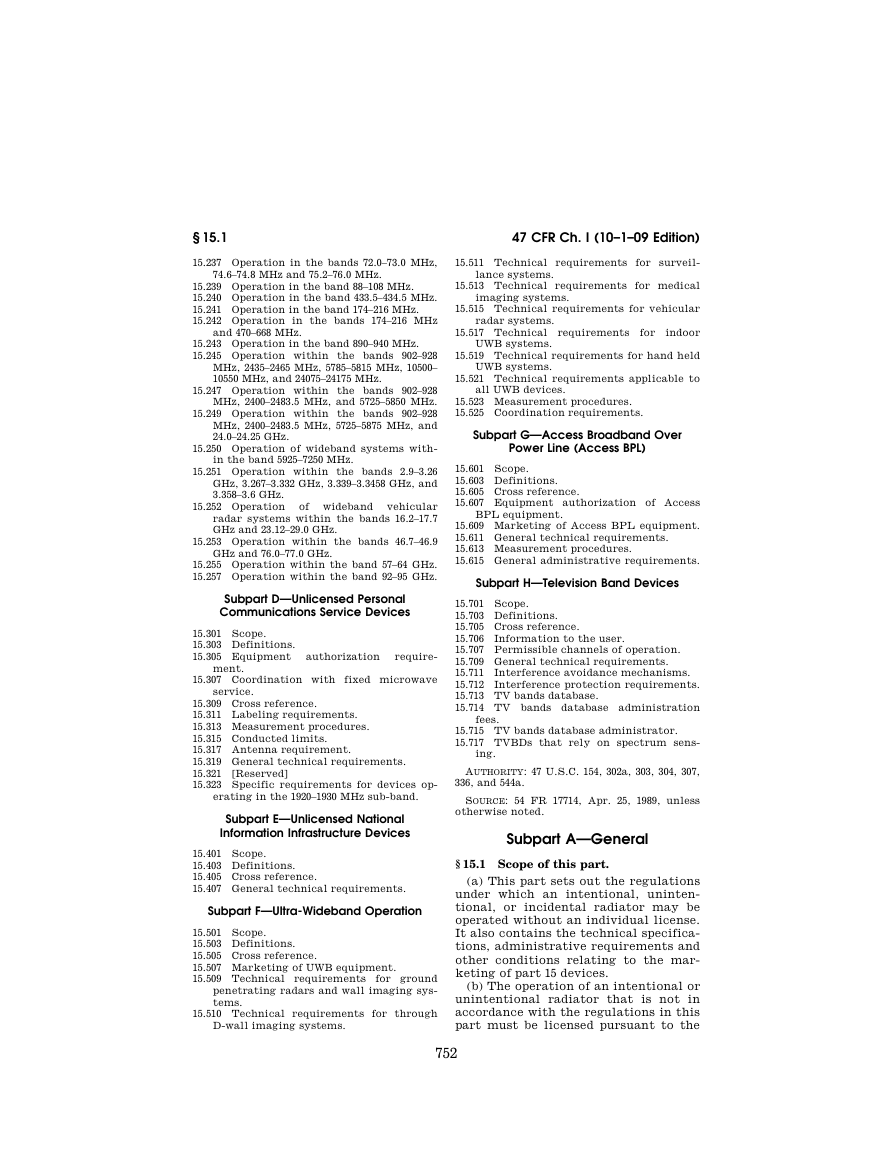
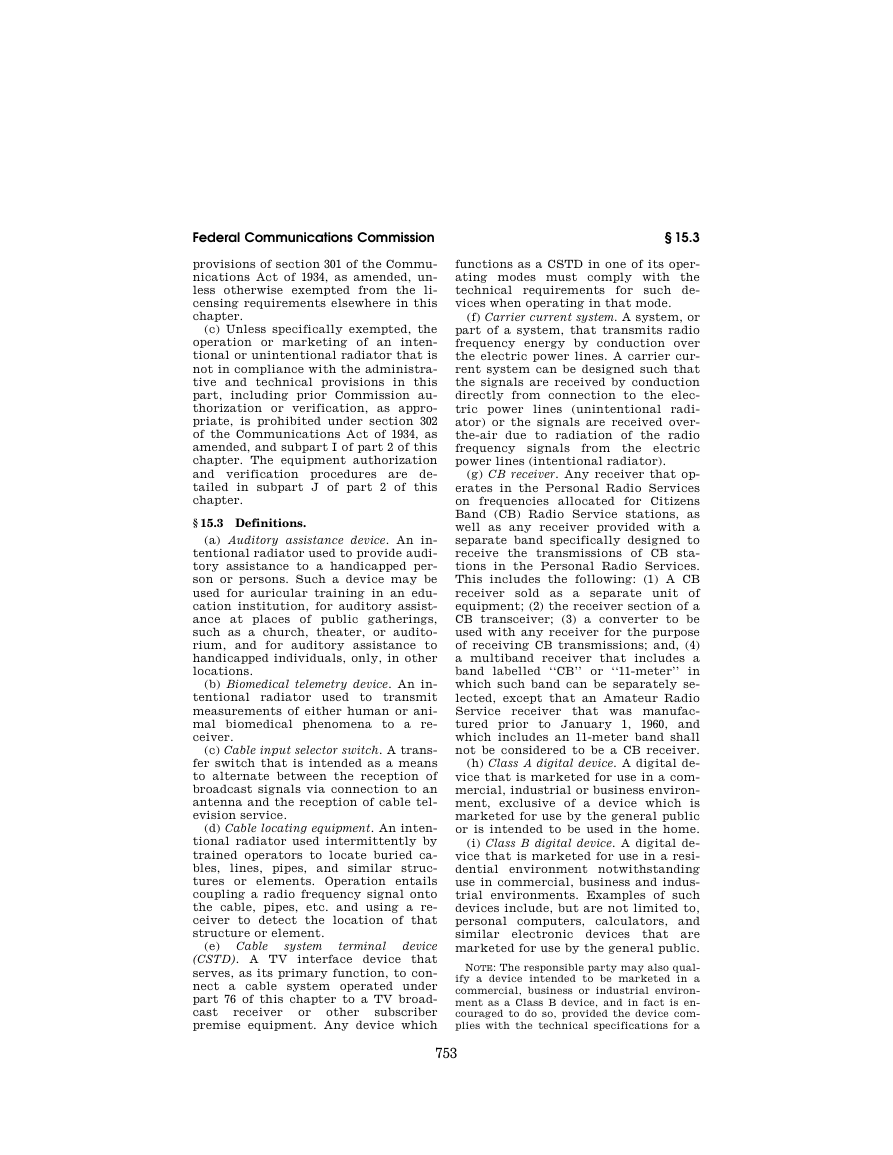
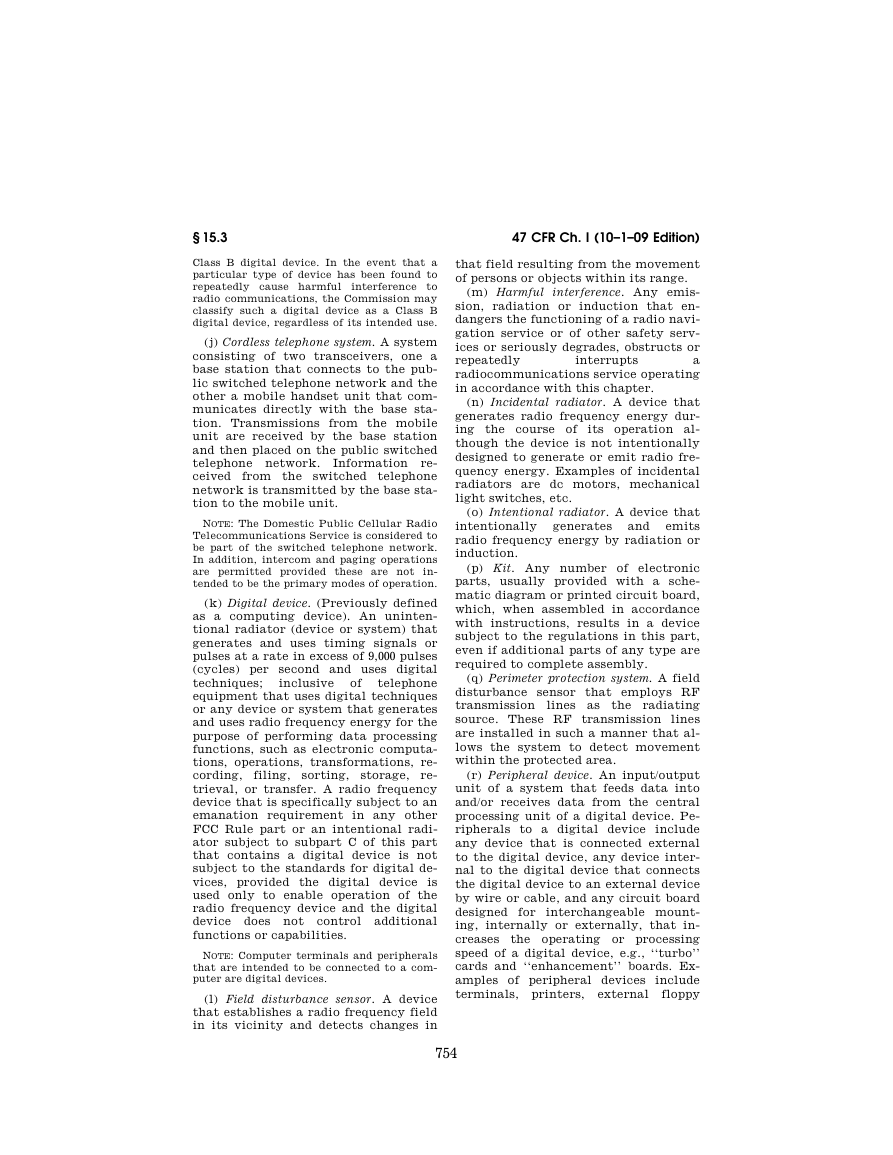
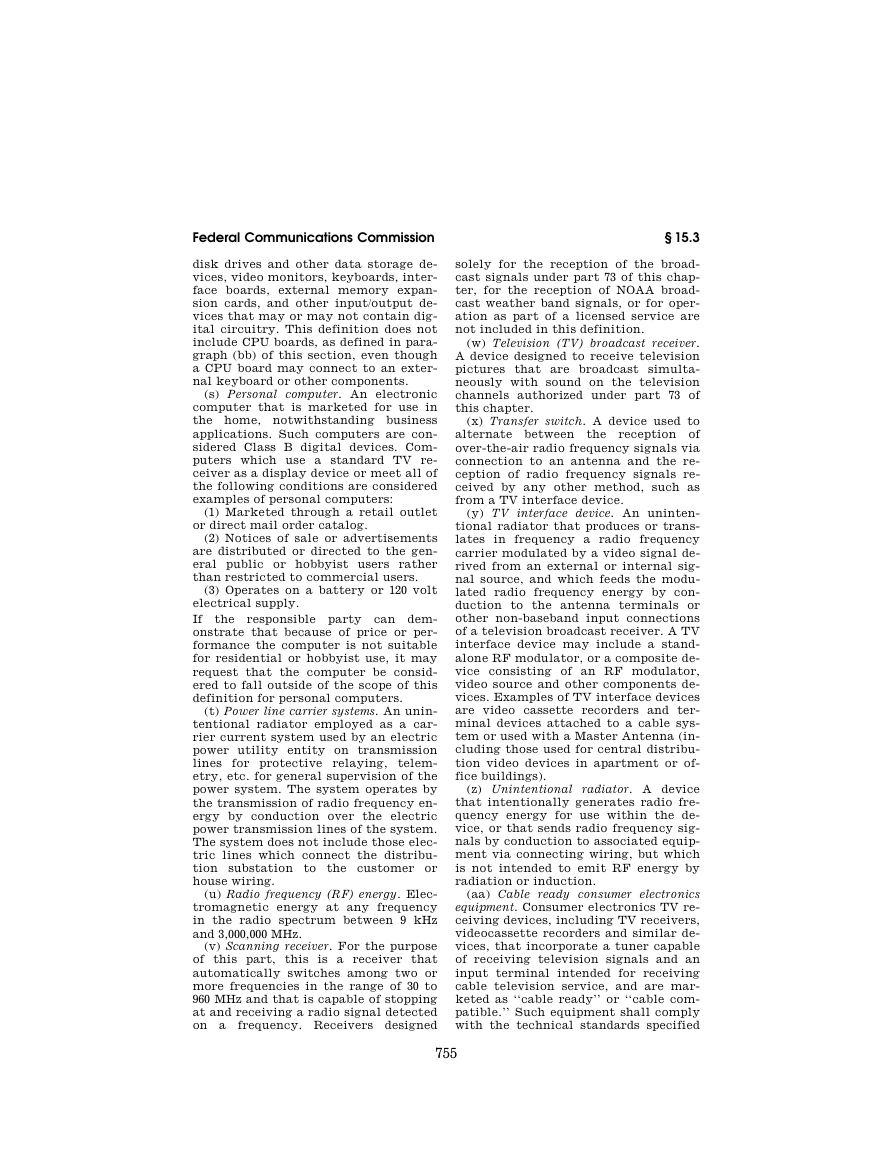
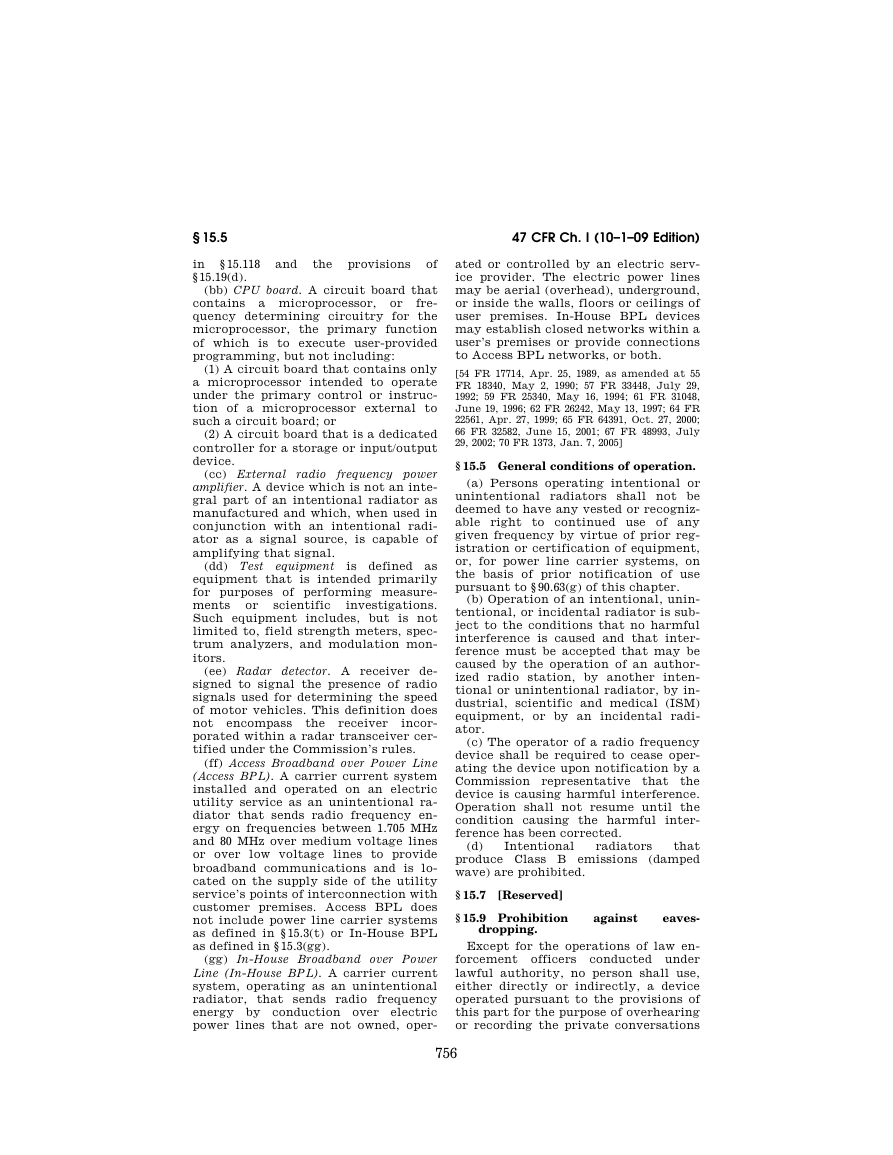
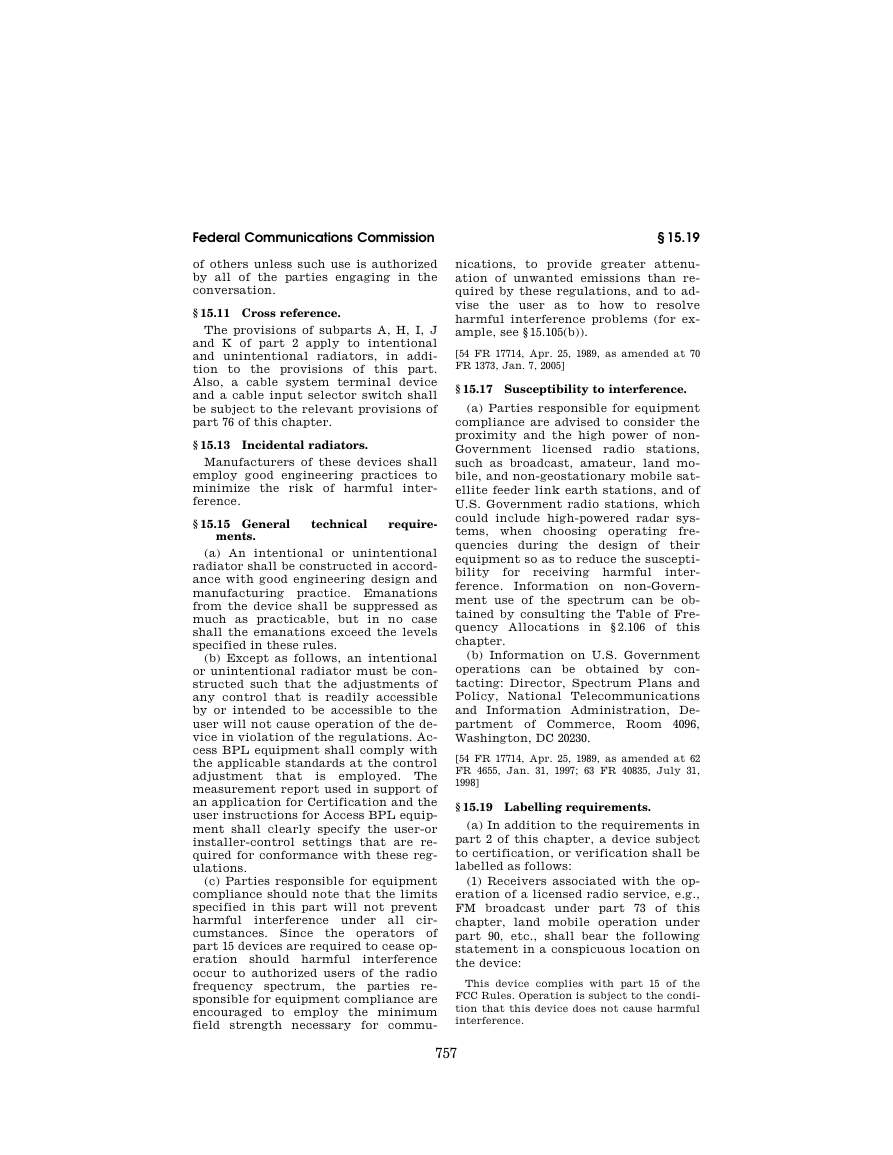
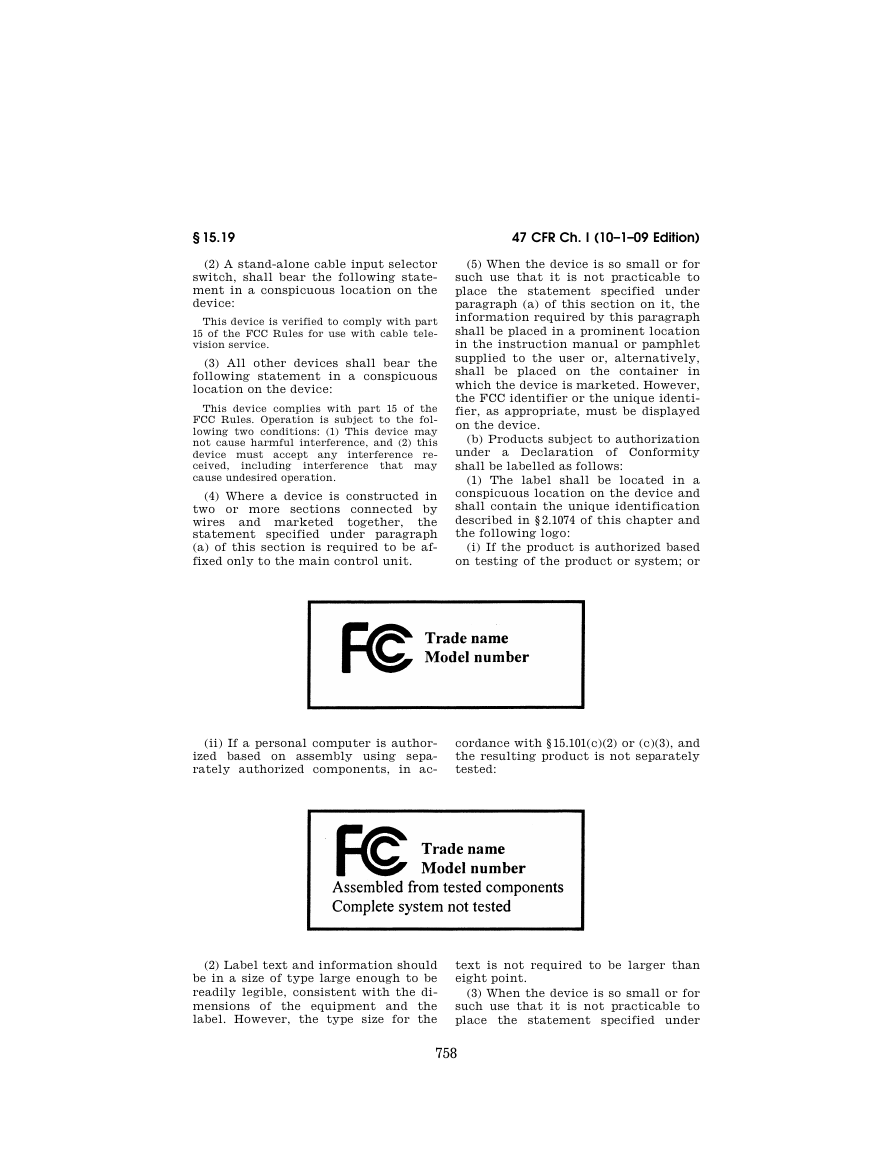









 2023年江西萍乡中考道德与法治真题及答案.doc
2023年江西萍乡中考道德与法治真题及答案.doc 2012年重庆南川中考生物真题及答案.doc
2012年重庆南川中考生物真题及答案.doc 2013年江西师范大学地理学综合及文艺理论基础考研真题.doc
2013年江西师范大学地理学综合及文艺理论基础考研真题.doc 2020年四川甘孜小升初语文真题及答案I卷.doc
2020年四川甘孜小升初语文真题及答案I卷.doc 2020年注册岩土工程师专业基础考试真题及答案.doc
2020年注册岩土工程师专业基础考试真题及答案.doc 2023-2024学年福建省厦门市九年级上学期数学月考试题及答案.doc
2023-2024学年福建省厦门市九年级上学期数学月考试题及答案.doc 2021-2022学年辽宁省沈阳市大东区九年级上学期语文期末试题及答案.doc
2021-2022学年辽宁省沈阳市大东区九年级上学期语文期末试题及答案.doc 2022-2023学年北京东城区初三第一学期物理期末试卷及答案.doc
2022-2023学年北京东城区初三第一学期物理期末试卷及答案.doc 2018上半年江西教师资格初中地理学科知识与教学能力真题及答案.doc
2018上半年江西教师资格初中地理学科知识与教学能力真题及答案.doc 2012年河北国家公务员申论考试真题及答案-省级.doc
2012年河北国家公务员申论考试真题及答案-省级.doc 2020-2021学年江苏省扬州市江都区邵樊片九年级上学期数学第一次质量检测试题及答案.doc
2020-2021学年江苏省扬州市江都区邵樊片九年级上学期数学第一次质量检测试题及答案.doc 2022下半年黑龙江教师资格证中学综合素质真题及答案.doc
2022下半年黑龙江教师资格证中学综合素质真题及答案.doc